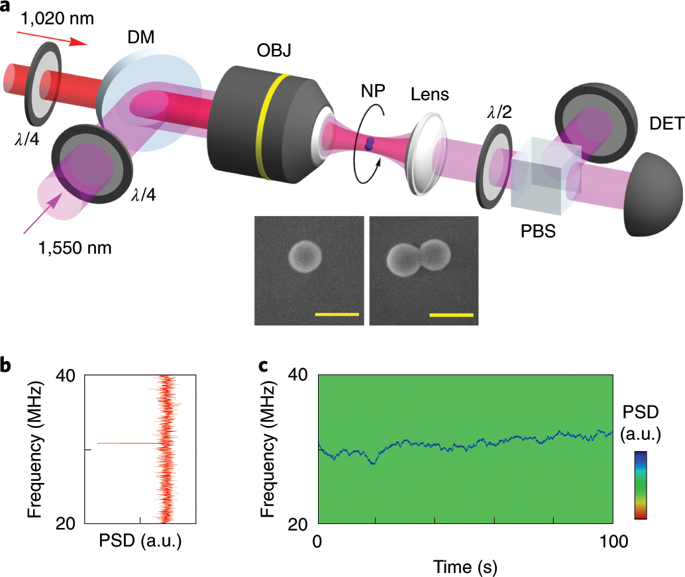Nature Nanotechnology ( IF 38.1 ) Pub Date : 2020-01-13 , DOI: 10.1038/s41565-019-0605-9 Jonghoon Ahn 1 , Zhujing Xu 2 , Jaehoon Bang 1 , Peng Ju 2 , Xingyu Gao 2 , Tongcang Li 1, 2, 3, 4

|
Torque sensors such as the torsion balance enabled the first determination of the gravitational constant by Henri Cavendish1 and the discovery of Coulomb’s law. Torque sensors are also widely used in studying small-scale magnetism2,3, the Casimir effect4 and other applications5. Great effort has been made to improve the torque detection sensitivity by nanofabrication and cryogenic cooling. Until now, the most sensitive torque sensor has achieved a remarkable sensitivity of 2.9 × 10−24 N m Hz−1/2 at millikelvin temperatures in a dilution refrigerator6. Here, we show a torque sensor reaching sensitivity of (4.2 ± 1.2) × 10−27 N m Hz−1/2 at room temperature. It is created by an optically levitated nanoparticle in vacuum. Our system does not require complex nanofabrication. Moreover, we drive a nanoparticle to rotate at a record high speed beyond 5 GHz (300 billion r.p.m.). Our calculations show that this system will be able to detect the long sought after vacuum friction7,8,9,10 near a surface under realistic conditions. The optically levitated nanorotor will also have applications in studying nanoscale magnetism2,3 and the quantum geometric phase11.
中文翻译:

使用光学悬浮纳米转子进行超灵敏扭矩检测
扭力天平等扭矩传感器使亨利卡文迪许一号首次确定了引力常数并发现了库仑定律。扭矩传感器还广泛用于研究小规模磁性2,3、卡西米尔效应4和其他应用5。通过纳米加工和低温冷却,人们已经做出了巨大的努力来提高扭矩检测灵敏度。迄今为止,最灵敏的扭矩传感器已在稀释制冷机6中的毫开尔文温度下实现了 2.9 × 10 -24 N m Hz -1/2的卓越灵敏度。在这里,我们展示了一个扭矩传感器达到 (4.2 ± 1.2) × 10 -27 N m Hz的灵敏度-1/2在室温下。它是由真空中的光学悬浮纳米粒子产生的。我们的系统不需要复杂的纳米加工。此外,我们驱动纳米粒子以超过 5 GHz(3000 亿转/分)的创纪录高速旋转。我们的计算表明,该系统将能够在现实条件下检测表面附近长期寻求的真空摩擦7、8、9、10 。光学悬浮纳米转子也将应用于研究纳米级磁性2,3和量子几何相11。











































 京公网安备 11010802027423号
京公网安备 11010802027423号